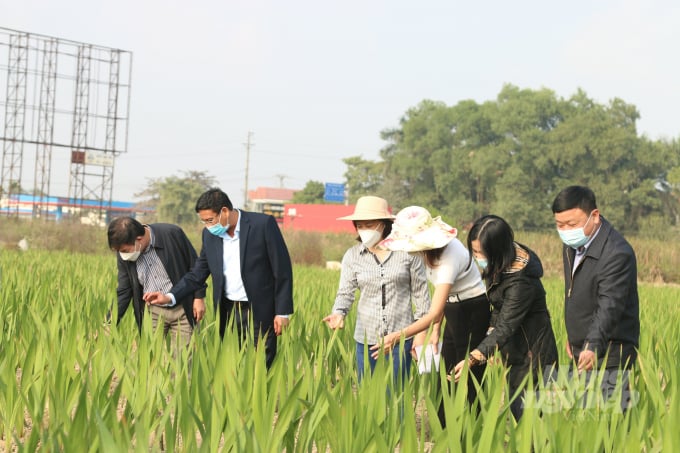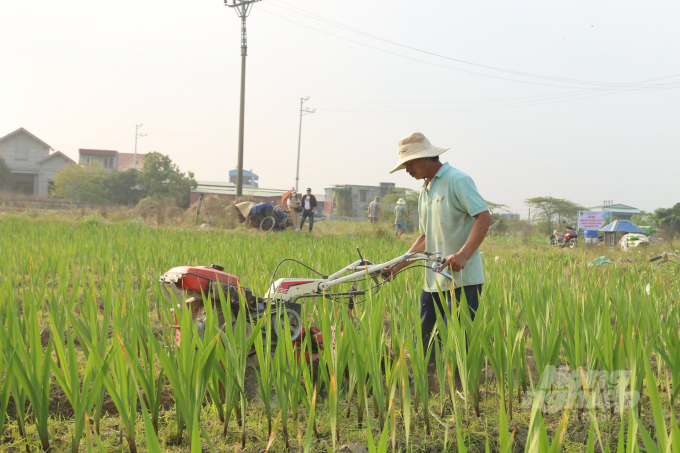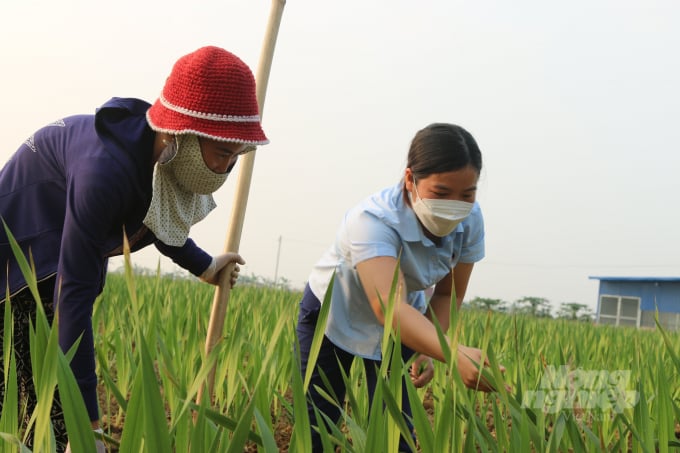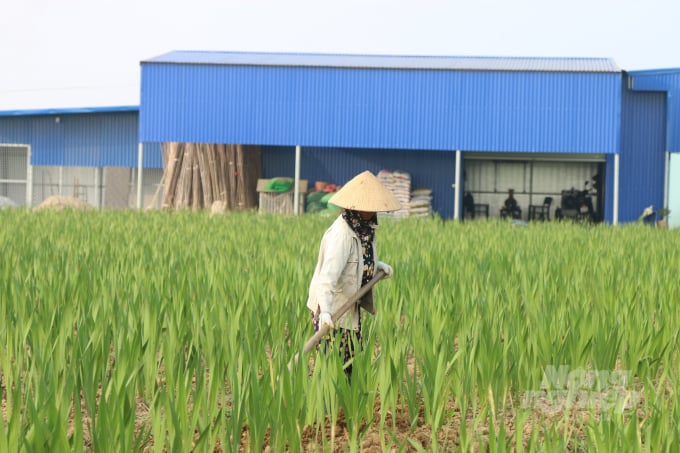November 20, 2025 | 13:02 GMT +7
November 20, 2025 | 13:02 GMT +7
Hotline: 0913.378.918
November 20, 2025 | 13:02 GMT +7
Hotline: 0913.378.918

Hải Phòng City's agriculture officials visit a gladiolus growing model that use organic fertilisers. Photo: Đinh Muoi.
Having grown gladiolus for many years, farmer Nguyen Thanh Hiep in Nam Binh village, An Hung Commune, An Duong District, used to use many non-organic fertilisers and plant protection. As a result, his gladiolus was usually not as beautiful and profitable as expected.
In 2021, Hai Phong Agricultural Extension Centre selected his farm to deploy the model "Application of technical advances in gladiolus production associated with product consumption".
During the implementation process, the centre assigned two officers in charge of the model including one agricultural extension officer and the other from the Startup Consulting Department. They regularly monitored and inspected the fields, guiding producers to record, water, fertilise, nurse and prevent pests throughout the growth process of flowering plants until harvest.
Farmers were also given gladiolus bulbs and microbial organic fertilisers. Hiep was instructed to select Da Lat gladiolus – the variety with crimson flower colour, short growth time and better resistance against Pestalotia funereal.
Although it has not yet been harvested, according to the preliminary assessment of technicians, local authorities as well as model owners, the flowers are more beautiful, the leaves are greener. They expect to have a bountiful flower crop this year.

A farmer use a machine in gladiolus farming. Photo: Dinh Muoi.
Hiep said that as recommended by the authorities, he used organic fertilisers and changed the structure of crops. After the flower crop, he planted melons and one rice crop to limit pests and diseases, limited the use of pesticides to ensure economic profits, protect the environment, and protect growers' health.
On the other hand, thanks to the technical guidance of agricultural extension officers and the use of organic fertilisers, he grew the flowers for just 85-90 days, expecting to harvest about 300,000 flowers and get more than VND1 billion as growing 1.5 ha of flowers.
“My family has been growing flowers for a long time, but they have never seen flowers as green and beautiful as the year before,” Hiep said.
In An Duong district, other gladiolus growing models also used organic microbial fertilisers in Dai Ban commune. Farmers there also changed crop structure and accumulated land for large flower growing areas also saw much better results than traditional farming.

An agriculture officer instruct a farmer yo nurse flowers. Photo: Dinh Muoi.
According to the Hai Phong Agricultural Extension Centre, the application of new varieties and micro-organic fertilisers helps gladiolus plants to have good resistance to adverse external conditions and pests, and to grow better, thus improving the quality of commercial flowers, increasing economic efficiency and income for flower producers.
During the production process, the centre guided farmers to use VN3 microbial organic fertiliser to provide a full range of beneficial microorganisms, support the decomposition of organic matters to create nutrients for flowering plants, help them better absorb minerals in the soil.

Farmers can sell a gladiolus for VND 6,000 -8,000 in market during Lunar New Year celebration. Photo: Dinh Muoi
Nguyen Ngoc Dam, Director of Hai Phong Agricultural Extension Centre said that the successful implementation of the models contributed to building a suitable gladiolus production process for flower production areas in Hai Phong.
Thereby, farmers step by step applied new seed technology, microbial organic fertilisers to flower production in the direction of developing ecological urban agriculture for suburban areas, he said.
Besides supports in productions, farming households were helped to consume their flowers in fresh flower shops, wholesale markets in Hai Phong and neighbouring provinces.
“The use of organic fertilisers in gladiolus production also contributes to soil improvement, environmental protection, and safety for the health of producers as well as buyers. The model will offer experiences for flower production in neighbouring areas. The model will be expanded across the city,” Dam said.
Bui Thanh Tung, Deputy Director of Hai Phong City’s Department of Agriculture and Rural Development, said that organic agriculture was the direction for the future and the city had been taking steps to develop organic farming.
In 2019, Hai Phong City issued regulations on organic farming. In 2020, Hai Phong City assigned the Agriculture and Rural Development sector to implement a project to identify organic farming areas.
“Currently, the agricultural sector in Hai Phong is taking steps to establish a scheme to identify organic production areas. On that basis, the agricultural sector will advise the Hai Phong City People's Committee to build incentive mechanisms, supporting the development of organic production in the area for the period of 2021-2025,” he said.
Translated by Hien Anh

(VAN) This is the study conducted by IRRI and Can Tho University on the rice straw value chain in Mekong Delta showing an economic potential of more than 6.6 trillion VND/year.

(VAN) By participating in cooperative economics, many farmers in Tay Ninh have overcome hardship, mastered clean dragon fruit cultivation techniques.

(VAN) The crossbreeding program in the former Binh Dinh province (now part of Gia Lai) has shown signs of decline, and urgent measures are needed to revive it and sustain past achievements.

(VAN) The agricultural sector agreed on a roadmap to pilot the MRV protocol and expand low-emission rice production from the 2025-2026 winter-spring crop.

(VAN) Agricultural extension officers in Quang Ninh do more than transmit knowledge; they have become a steadfast support system for farmers on the path to sustainable agricultural development.

(VAN) The development of a high-quality beef cattle herd has brought major benefits to livestock farmers, creating jobs and enabling better use of agricultural by-products.

(VAN) In the eastern region of Gia Lai, crossbred cattle now account for 93%, forming a high-quality beef herd and establishing a recognized brand, the result of 35 years of persistent effort.